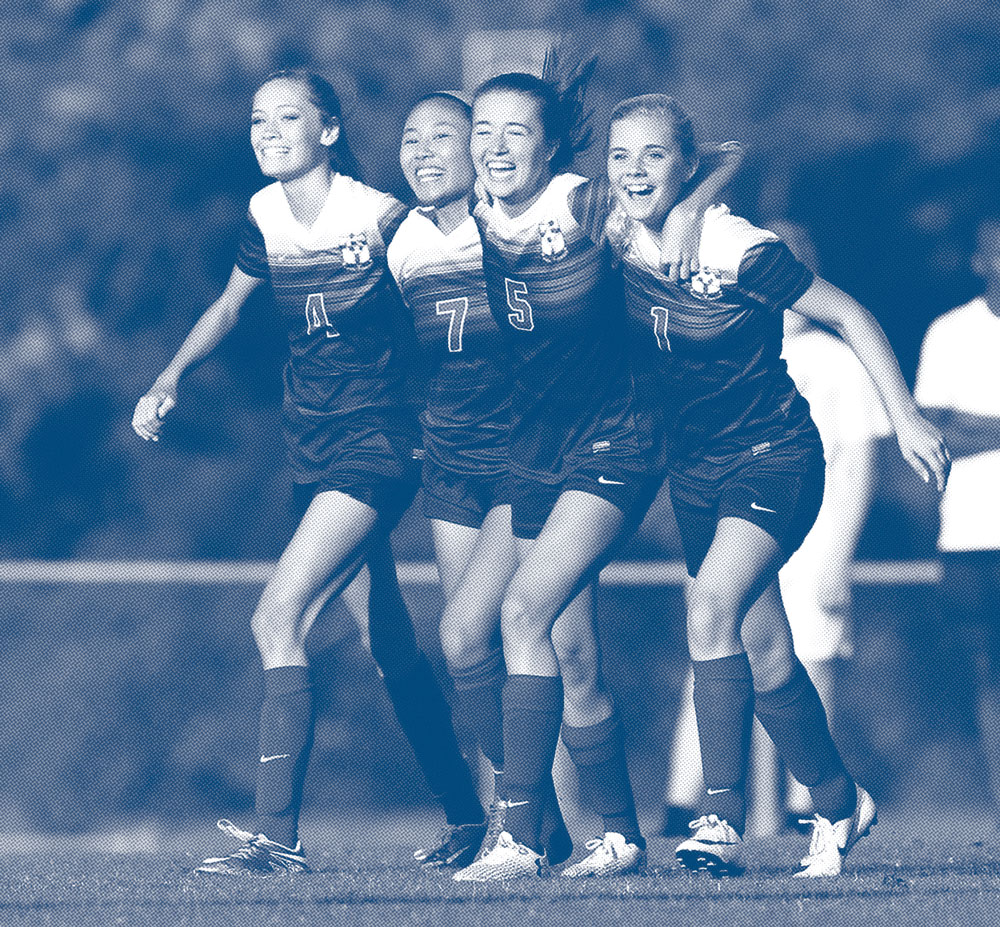Rankings in orange circles compare this sport with nine other sports offered for this gender before customization – meaning each of the three health categories is given an equal one-third weighting. The ranking is comprised of data collected or developed from various sources (75% of score) and expert opinion (25% of score). The healthiest sports in each of the three categories – physical activity, safety and psychosocial benefits – and in each data measurement are ranked No. 1. Note: Some sports did not have significant differences between each other in the data. Learn more about our methodology.
2nd
out of 10
Physical Activity
Expert Opinion Rank: T-3rd Out of 10
Key Characteristics: Soccer physical activity at practices ranks second among the 10 girls sports studied by North Carolina State University. Soccer has 55.5 percent vigorous activity; the 10 girls sports average 39.6 percent. Soccer practice time focuses 31 percent on game play and 27 percent on skills compared to 15 percent on fitness.
1 North Carolina State University research observing high school athletes in North Carolina, 2017-18.
10th
out of 10
Safety
26.6
Injury Rate2(10th out of 10)
11.5%
Injury Time/Loss3(8th out of 10)
0.01
Catastrophic Rate4(T-4th out of 10)
6.4%
Injuries Requiring Surgery5(8th out of 10)
7.1
Concussion Rate6(10th out of 10)
Expert Opinion Rank: 10th Out of 10
Key Characteristics: Soccer has the highest injury rate among girls sports, according to the National High School Sports-Related Injury Surveillance Study. The most common injuries are to the head/face, ankle and knee. Other than football, soccer’s concussion rate for girls is the highest for any sport regardless of gender.
2 Injury rate per 10,000 exposures, National High School Sports-Related Injury Surveillance Study, 2016-17.
3 Percentage of all injuries resulting in greater than three weeks of time loss from the sport, National High School Sports-Related Injury Surveillance Study, 2016-17.
4 Non-fatal catastrophic injury/illness rate per 100,000 exposures, National Center for Catastrophic Sport Injury Research, 1982-2016.
5 Percentage of all injuries requiring surgery, National High School Sports-Related Injury Surveillance Study, 2016-17.
6 Concussion rate per 10,000 exposures, National High School Sports-Related Injury Surveillance Study, 2016-17.
3rd
out of 10
Psychosocial
Aspen Psychosocial Survey7
3.7
Personal Social Skills(2nd out of 10)
2.952
Cognitive Skills(1st out of 10)
3.67
Goal-Setting(6th out of 10)
3.809
Initiative(3rd out of 10)
3.71
Health(3rd out of 10)
1.595
Negative Experiences(4th out of 10)
Substance Abuse
Cigarette Use8
8.7%
(4th out of 10)
Binge Drinking9
20.3%
(8th out of 10)
Marijuana Use10
17%
(5th out of 10)
Academic Achievement
Cut Class11
27.8%
(7th out of 10)
A/A- Student12
46.8%
(6th out of 10)
Graduate From College13
75.5%
(4th out of 10)
Psychological health14
How We Define Our Metrics
4.09
Self-Esteem(9th out of 10)
2.19
Fatalism(T-8th out of 10)
3.76
Self-Efficacy(10th out of 10)
2.75
Loneliness(5th out of 10)
2.08
Self-Derogation(10th out of 10)
4.27
Social Support(4th out of 10)
Expert Opinion Rank: T-2nd Out of 10
Key Characteristics: Soccer rates second among the 10 girls sports in the Aspen Institute/University of Texas psychosocial survey, barely behind No. 1 softball. Developing cognitive and social skills are strengths for soccer. The sport has the fourth-best score for social support, according to Women’s Sports Foundation data.
7 Aspen Institute/University of Texas psychosocial benefits survey of high school athletes nationally, 2018. Scoring ranges from 1-4, with 4 being the best except for the Negative Experiences category.
8 Percentage of high school seniors in the sport smoking cigarettes in the past 30 days. Data from Monitoring the Future Study (2010-15) and analyzed by Women’s Sports Foundation in Teen Sport in America: Why Participation Matters.
9 Percentage of high school seniors in the sport binge drinking alcohol in the past two weeks. Data from Monitoring the Future Study (2010-15) and analyzed by Women’s Sports Foundation in Teen Sport in America: Why Participation Matters.
10 Percentage of high school seniors in the sport using marijuana in the past 30 days. Data from Monitoring the Future Study (2010-15) and analyzed by Women’s Sports Foundation in Teen Sport in America: Why Participation Matters.
11 Percentage of high school seniors in the sport who cut class for a full day in the past month. Data from Monitoring the Future Study (2010-15) and analyzed by Women’s Sports Foundation in Teen Sport in America: Why Participation Matters.
12 Percentage of high school seniors in the sport who have an average grade of an A or A-. Data from Monitoring the Future Study (2010-15) and analyzed by Women’s Sports Foundation in Teen Sport in America: Why Participation Matters.
13 Percentage of high school seniors in the sport who expect to graduate from a four-year college. Data from Monitoring the Future Study (2010-15) and analyzed by Women’s Sports Foundation in Teen Sport in America: Why Participation Matters.
14 Average scores of high school seniors in the sport in psychological health report card. Data for these six categories came from Monitoring the Future Study (2010-15) and analyzed by Women’s Sports Foundation in Teen Sport in America: Why Participation Matters. Scoring ranges from 1-5, with 5 being the best for self-esteem, self-efficacy and social support.



